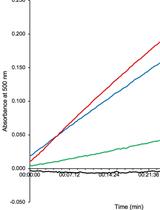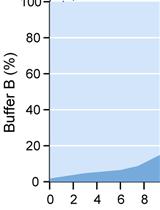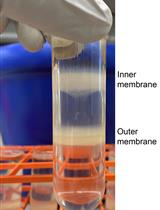- Submit a Protocol
- Receive Our Alerts
- EN
- EN - English
- CN - 中文
- Protocols
- Articles and Issues
- For Authors
- About
- Become a Reviewer
- EN - English
- CN - 中文
- Home
- Protocols
- Articles and Issues
- For Authors
- About
- Become a Reviewer
Rapid Nitrate Reduction Assay with Intact Microbial Cells or Spores
Published: Vol 4, Iss 12, Jun 20, 2014 DOI: 10.21769/BioProtoc.1154 Views: 8128
Reviewed by: Anonymous reviewer(s)

Protocol Collections
Comprehensive collections of detailed, peer-reviewed protocols focusing on specific topics
Related protocols

Detection of D-glutamate Production from the Dual Function Enzyme, 4-amino-4-deoxychorismate Lyase/D-amino Acid Transaminase, in Mycobacterium smegmatis
Helen K. Opel-Reading [...] Kurt L. Krause
Jan 5, 2019 4893 Views

Analysis of Gram-negative Bacteria Peptidoglycan by Ultra-performance Liquid Chromatography
Laura Alvarez [...] Felipe Cava
Oct 5, 2020 3578 Views

Separating Inner and Outer Membranes of Escherichia coli by EDTA-free Sucrose Gradient Centrifugation
Sheng Shu and Wei Mi
Mar 20, 2023 767 Views
Abstract
Many microorganisms have the capacity to use nitrate as a respiratory electron acceptor. Reduction of nitrate is catalyzed by a multi-subunit nitrate reductase that is often located associated with the cytoplasmic membrane and has its active site oriented toward the cytoplasm. This means that nitrate must be transported into the cell and often this occurs concomitantly with the export of the reduced nitrite product. Often nitrate and nitrite transport are coupled through the action of a nitrate: nitrite antiporter. Microbial cells, spores and mycelium harbour intracellular storage compounds such as trehalose or glycogen that, upon metabolism, function as endogenous electron donors for nitrate reduction. It is also possible to use glucose supplied exogenously as a substrate for nitrate reduction. The method described here allows the direct analysis of nitrate reduction by whole cell material without the requirement for artificial electron donors. This method is also applicable to the study of spores, particularly those of Streptomyces species (Fischer et al., 2013). The paper by Fischer et al. 2013 provides examples of datasets for the method presented below.
Keywords: Nitrate reductaseMaterials and Reagents
- Freshly harvested Streptomyces spores in water or mycelium in 50 mM MOPS buffer (pH 7)
- Tryptic Soy Broth (TSB) (Sigma-Aldrich, catalog number: 22092 )
- 3-(N-morpholino)propanesulfonic acid (MOPS) buffer (Roth North America)
- Sulfanilic acid (Sigma-Aldrich, catalog number: 251917 )
- N-(1-naphthyl)-ethylenediamine dihydrochloride (Roth North America)
- Hydrochloric acid (Roth North America)
- Sodium hydroxide pellets (Roth North America)
- Soya flour (from local supermarket)
- D-mannitol (Sigma-Aldrich catalogue number 63560 )
- Agar-agar (Kobe I) (Roth North America)
- Sulfanilic acid solution (see Recipes)
- N-(1-naphthyl)-ethylenediamine solution (see Recipes)
- MOPS-buffer (see Recipes)
- SFM agar (see Recipes)
Equipment
- Cotton wool (standard issue from local pharmacy)
- 0.22 µm pore-size filters (PVDF) (Roth North America)
- 30 °C rotary shaker
- Baffled Erlenmeyer flasks (500 ml) (Glasgerätebau Ochs, Laborfachhandel e. K., catalog number: 100500 )
- Standard-sized plastic Petri dishes for bacterial growth and spore preparation
- Gas-tight glass Hungate tubes (16 ml) for anaerobic work with butyl rubber septa (Glasgerätebau Ochs, Laborfachhandel e. K., catalog number: 1020471 )
- Cooled table-top centrifuge (e.g. Eppendorf)
- Cylinder of pure nitrogen gas (e.g. Linde or local supplier)
- Needles 0.6 mm Gauge (B. Braun Melsungen AG)
- Water bath or heating block (Biometra)
- Spectrophotometer measuring absorption in the visible range
Procedure
- Incubation assay for Streptomyces spores
- Suspensions of freshly harvested spores, which were washed with water and filtered twice through cotton wool (Kieser et al., 2000), were adjusted to an OD450nm of 10 or 20 (1 ml of an OD450 = 1 is equivalent to 3.5 x 108 spores ml−1 or 2.37 x 108 cfu.).
- For the assay, 500 μl of the spore suspension was added to 500 μl of buffer (100 mM MOPS-NaOH, pH 7.0, 10 mM sodium nitrate) in gas-tight Hungate vials. The gas in the 15 ml headspace was exchanged against pure nitrogen and flushed with nitrogen for an additional 5 min through the closed septum.
- Hungate vials were incubated by slowly shaking at 30 °C for 5 h, or longer as necessary if the anticipated enzyme activity was low.
- At a defined time after starting the incubation the nitrate reduction reaction in these samples was terminated by heating the vials with the spores at 80 °C for 10 min. The heat-killed spores were then pelleted by centrifugation in a bench-top centrifuge (20,000 x g) for 5 min.
- The spore-free supernatant was used for nitrite determination either immediately or was stored at -20 °C until required.
- Suspensions of freshly harvested spores, which were washed with water and filtered twice through cotton wool (Kieser et al., 2000), were adjusted to an OD450nm of 10 or 20 (1 ml of an OD450 = 1 is equivalent to 3.5 x 108 spores ml−1 or 2.37 x 108 cfu.).
- Incubation assay for Streptomyces mycelia grown in TSB liquid culture
- Suspensions of freshly grown, highly dispersed mycelium were washed twice with MOPS-buffer, and adjusted to the desired amount of mycelium using the methylene blue adsorption method (Fischer and Sawers, 2013; see notes below) (1,000 CAE are comparable with a dry weight of 1 mg Streptomyces mycelium growing in TSB.).
- For the assay, 500 μl of the mycelium suspension were added to 500 μl of buffer (100 mM MOPS-NaOH, pH 7.0, 10 mM sodium nitrate) in gas-tight Hungate vials. The gas in the 15 ml headspace was exchanged against pure nitrogen and flushed with nitrogen for an additional 5 min through the closed septum.
- The Hungate vials were incubated by slowly shaking at 30 °C for 30 min, or longer as necessary.
- For the determination of rates of nitrate reduction in mycelium, samples were removed at different times. The nitrate reduction reaction in these samples was terminated by heating the vials at 80 °C for 10 min.
- The mycelium-free supernatant, obtained by centrifuging the vials for 5 min at 5,000 x g in a bench-top centrifuge, was used for nitrite determination.
- Suspensions of freshly grown, highly dispersed mycelium were washed twice with MOPS-buffer, and adjusted to the desired amount of mycelium using the methylene blue adsorption method (Fischer and Sawers, 2013; see notes below) (1,000 CAE are comparable with a dry weight of 1 mg Streptomyces mycelium growing in TSB.).
- Nitrite determination in the supernatant of bacterial cultures (Rider and Mellon, 1946)
- Aliquots (0.5 ml) of the supernatants were mixed by briefly pipetting up and down twice with one volume of freshly prepared sulfanilic acid solution and incubated at room temperature for at least 5 min. If the absorbance levels were too high, then supernatants were appropriately diluted (1:5 or 1:10) prior to repeating the nitrite determination assay.
- Subsequently, a half volume of N-(1-naphthyl)-ethylenediamine solution was added and the incubation was continued for exactly 10 min.
- The absorption was measured at 540 nm and the nitrite concentration was calculated using a calibration curve with nitrite.
- Aliquots (0.5 ml) of the supernatants were mixed by briefly pipetting up and down twice with one volume of freshly prepared sulfanilic acid solution and incubated at room temperature for at least 5 min. If the absorbance levels were too high, then supernatants were appropriately diluted (1:5 or 1:10) prior to repeating the nitrite determination assay.
Notes
- A modification of the method to allow a rapid and qualitative assessment for incubation/ growth of spores and mycelia on solid nutrient broth is described in Fischer et al. (2013).
- The precise details of the methylene blue adsorption method are available in Fischer and Sawers (2013). A bioprotocol detailing this method will be submitted in the near future.
Recipes
- Sulfanilic acid solution
Sulfanilic acid (4% w/v) was solubilized in 25% (w/v) HCl at RT to deliver a saturated solution
- N-(1-naphthyl)-ethylenediamine solution
Used as 0.2 % (w/v) solution in distilled water
Can be stored at 4 °C for up to one week
- MOPS-buffer
Adjusted to pH 7.2 with NaOH
Sterilized by filtration through a 0.22 µm filter
- SFM agar
20 g L−1 soya flour
20 g L−1 D-mannitol
Agar-agar (Kobe I)
Acknowledgments
This method was reliant on the assay to determine nitrite concentrations developed by Rider and Mellon (1946), published in Industrial and Engineering Chemistry Analytical Edition. This work was supported by the Deutsche Forschungsgemeinschaft (SA 494/4-1).
References
- Fischer, M. and Sawers, R. G. (2013). A universally applicable and rapid method for measuring the growth of Streptomyces and other filamentous microorganisms by methylene blue adsorption-desorption. Appl Environ Microbiol 79(14): 4499-4502.
- Fischer, M., Falke, D. and Sawers, R. G. (2013). A respiratory nitrate reductase active exclusively in resting spores of the obligate aerobe Streptomyces coelicolor A3(2). Mol Microbiol 89(6): 1259-1273.
- Kieser, T., Bibb, M. J., Buttner, M. J., Chater, K. F. and Hopwood, D. A. (2000). Practical Streptomyces Genetics. Norwich: The John Innes Foundation.
- Rider, B. and Mellon, M. (1946). Colorimetric determination of nitrites. Industrial & Engineering Chemistry Analytical Edition 18(2): 96-99.
Article Information
Copyright
© 2014 The Authors; exclusive licensee Bio-protocol LLC.
How to cite
Fischer, M., Falke, D. and Sawers, R. G. (2014). Rapid Nitrate Reduction Assay with Intact Microbial Cells or Spores. Bio-protocol 4(12): e1154. DOI: 10.21769/BioProtoc.1154.
Category
Microbiology > Microbial biochemistry > Other compound
Microbiology > Microbial metabolism > Nutrient transport
Do you have any questions about this protocol?
Post your question to gather feedback from the community. We will also invite the authors of this article to respond.
Tips for asking effective questions
+ Description
Write a detailed description. Include all information that will help others answer your question including experimental processes, conditions, and relevant images.
Share
Bluesky
X
Copy link










